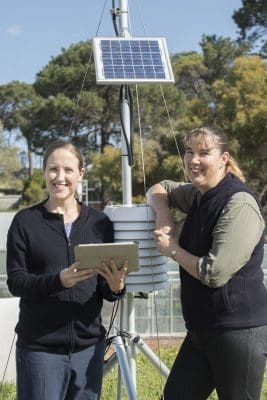A NEW tool is available to assist Western Australian grain growers determine from home whether their crops may have been affected by extreme temperature events.

DPIRD development officer Kelly Ryan and research officer Dr Meredith Guthrie check out the department’s new online Extreme Weather Events tool at its South Perth weather station.
The WA Department of Primary Industries and Regional Development’s (DPIRD) eConnected Grainbelt project has developed an Extreme Weather Events tool, which provides temperature information for specific locations.
The free, online tool draws on data from the department’s network of 177 weather stations to provide both real time and historical data.
DPIRD research officer Meredith Guthrie said the tool would assist growers to understand how their crop potential was affected by extreme weather events, like frost and heat stress.
“With the variable nature of extreme weather events and increasingly large properties, it can be difficult for growers to know if and how severely their crops have been affected,” she said.
“The Extreme Weather Events tool enables growers to identify areas at risk of frost or heat stress so they can assess the crop and determine the likely impact on yield and quality.”
Dr Guthrie said the tool was straight forward to use and could be applied either immediately or retrospectively, days or weeks after an event.
“The user simply selects the time period, which can be a day, night or range of days, the temperature threshold and type of summary,” she said.
“From this information, a map comes up that pinpoints the matches to the criteria, as well as a table that shows the time, temperature and duration.
“The table is most important, as it shows how long sub-zero or high temperatures have occurred, which can indicate the severity of frost and heat damage.”
Development officer Kelly Ryan said the impact of extreme weather events on crops varied extensively and cautioned growers to consider many factors when making assessments.
“The greatest damage from frost occurs when the plant is at the booting or grain ripening stages of growth,” Ms Ryan said.
“There are also many other factors that influence crop damage from frost, including temperature, humidity, wind, topography, soil type, crop species and variety and crop growth stage.
“Multiple factors also influence the impact of heat stress on crops, such as crop growth stage and soil water availability.
“Growers can use the department’s online Soil Water tool to assist their assessment of the risk of heat stress on crops.”
…………………….
Source: DPIRD
Search for the Extreme Weather Events tool on the department’s website agric.wa.gov.au, where the Soil Water tool can also be found.

HAVE YOUR SAY